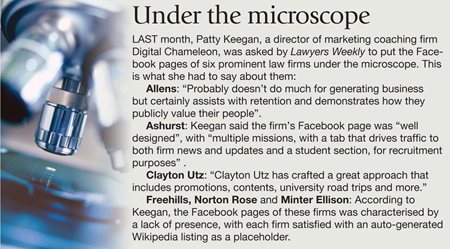Social climbers
Law firms have taken their first tentative steps into the social media sphere, but they still have much to learn about fully utilising it to the advantage of their business. Justin Whealing reports.

Law firms have taken their first tentative steps into the social media sphere, but they still have much to learn about fully utilising it to the advantage of their business. Justin Whealing reports
The use of social media by law firms has moved on from being a question of whether to use it to how it should be used.
That represents progress of sorts. However, Australia’s largest law firms are still suspicious of many of the various social and mobile media platforms out there, meaning that, for many law firms, its social media strategy is characterised more by what staff can’t do than by how the firm can best amplify its communications to the widest possible audience.
“Law firms are a fair way behind other professional services firms with regard to their use of social media,” says Pete Williams, Deloitte Digital CEO. “I have spoken to a dozen law firms over the last few years and there is an interest but not really a commitment or appetite to do stuff with it.”
Williams is not one to mince his words.
At the Janders Dean Law Firm Knowledge and Innovation Conference in September last year the noted social media spruiker and provocateur was heavily critical of law firms.
He said the vast majority of firms were not utilising social media in a meaningful way, meaning they were missing out on attracting the best graduates, engaging with clients, attracting new clients and building a reputation based on being a professional and modern practice.
“If what you are doing in IT or knowledge management doesn't have social [media] in it then stop and start again. It is as simple as that,” Williams said at the conference. “Your customers, staff and potential graduates all use it. The problem I see most of the time is from the attitude of leadership and management to its usage.”
Nine months on, Williams believes there has been little change in the attitudes of law firms to social media.
“I don’t get why they are not pumping stuff out,” says Williams. “Most law firms write newsletters and send out emails and those sorts of things but, as a whole, most are not blogging.
“We don’t see a lot of Twitter action with them. They are not using a lot of enterprise and they seem to be more focused on document management than true collaboration.”
In today’s ultra-competitive and global legal marketplace, “innovation” has become one of the key buzz words for law firms as they spruik their wares around town.
Williams believes that such a claim is incongruous if law firms don’t expand their methods of communication.
“If people look at law firms and see that they haven’t been able to keep up to date with the way society is moving and the way that people communicate it makes those claims look pretty thin,” he said. “If the attitude of your leadership is ‘social media is trivial, it is going away, it is a fad, it is not for us’ then you have a problem.
“You have to open your eyes and say ‘well, whether we like it or not, this is the way the world has moved’.”
Linking up
A clear divide has emerged between the types of social and mobile media law firms consider acceptable.
For many firms, Facebook is viewed as out of bounds with regard to most information. It is seen as a personal social media forum for staff to use independently in their spare time, with strict parameters placed around what professional information can be revealed.
On the other hand, LinkedIn has become a white-collar phenomenon. Firms regularly use it to reinforce connections with clients and to build the personal profiles of partners and rising stars in its ranks.
Allens is one high-profile firm that has virtually eschewed Facebook – with its Facebook page only having the barest of facts about the firm and only attracting 136 likes.
But, while it has deliberately shunned Facebook, Allens does have a social media strategy that targets other forms of media. Its partners are often featured on its website discussing contentious pieces of litigation or major business issues. It judiciously uses Twitter, a forum where the firm has 2512 followers, to tweet about major M&A transactions, and around 75 per cent of its staff is on LinkedIn.
“LinkedIn is a much more career-focused form of social media,” says Chris Fogerty, the director of corporate affairs at Allens. “We looked at where our focus and our investment would be with regards to our social media strategy and LinkedIn is an area where we think we get some real tangible benefit.”
Rules of engagement
King & Wood Mallesons has employed a vastly different social media strategy.
It has a highly-engaged Facebook page, with links to competitions, numerous photos of staff and many comments. Facebook has also become a critical tool in its graduate recruitment campaign.
“The ‘war for talent’ is not getting any easier, it’s actually getting harder to get traction and differentiate your brand,” says Sue Ashe, the head of communications at King & Wood Mallesons. “Around one and a half years ago we saw Facebook as a really good way of doing that.
 “We get a lot of traction via Facebook and we combine its use with traditional marketing, so we go on site [at universities] to careers fair, and off the back of that we get a lot of comments on our Facebook page.”
“We get a lot of traction via Facebook and we combine its use with traditional marketing, so we go on site [at universities] to careers fair, and off the back of that we get a lot of comments on our Facebook page.”
By using Facebook, LinkedIn and alumni networks for recruitment, Williams estimates that Deloitte has saved millions of dollars in recruitment fees and he can’t understand why law firms don’t adopt similar practices.
An interesting external and internal communications exercise that both Allens and King & Wood Mallesons had to negotiate recently concerned its respective tie-ups with overseas law firms.
The old Mallesons Stephen Jaques used social media heavily in the months leading up to its 1 March merger with King & Wood.
An added complication for Ashe and others within the firm’s communications team was how it negotiated the challenges of dealing with a Chinese-based firm that operates in a country that is subject to a communist dictatorship where the dissemination of information is tightly controlled.
“With different jurisdictions and rules and regulations it is really difficult to get a truly consistent social media message in terms of a global communications campaign,” says Ashe. “We were very cognisant of the fact that it was different in China and we rightly treated it differently as well so we were very sensitive as to what we could and couldn’t do.”
Top down
The executive teams at Australia’s leading law firms are used to discussing policies with regard to lateral partner recruitment campaigns, practice group reviews, remuneration packages and billable hours’ targets, but not how to best use social media.
However, that is starting to change as firms realise its importance on a strategic level.
“The way we approached it was that a couple of years ago we got a cross-section of people at the firm who were interested in this sphere and in the social media space,” says Allens’ Fogerty. “They developed a series of recommendations that went to the leadership team, which were then were woven into our existing policies.
“The approach we have taken is that social media is another form of communication, in a similar way to emails, phone calls and conversations with friends, and there are some very strict guidelines around that in terms of our policies.”
Williams believes that a law firm won’t get the most out of its use of social media policy unless it’s fully supported by senior management.
“I did a presentation for one of the big legal firms where the partners were like ‘wow, this is fantastic’, but then I talked to the staff and the feedback I got was, ‘no, I am not allowed to do that, we are not allowed to do this, and we also can’t do that’.
“I looked at that and it is probably the policies set at the IT level rather than the senior partners. When I talked to the senior partners they got it and their clients were completely engaged by it, but I think it was the IT department that had blocked it,” he says ruefully down the phone from the USA where he is attending a ‘futurist conference’.
“I think this stuff needs to be elevated around the partnership executive table, and not left with the IT operations group, because it is becoming strategic.”

